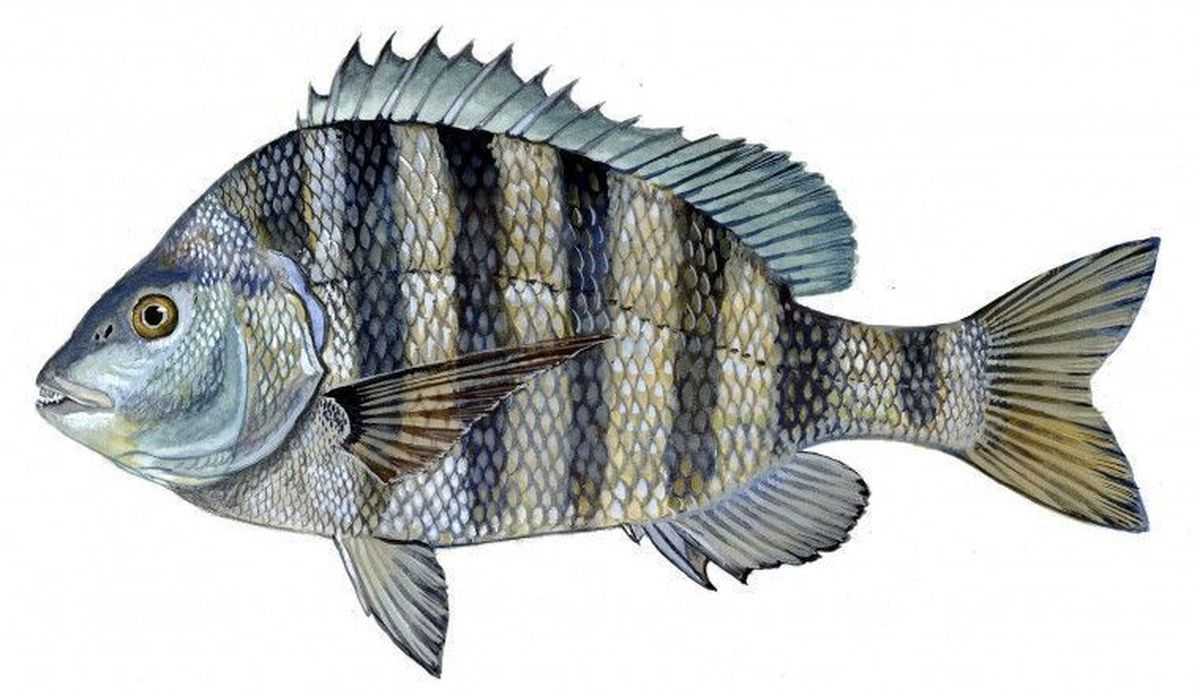Sheepshead

Species Details
Archosargus Probatocephalus
Sparidae
Perciformes
Onshore, Nearshore, Offshore, Reef, Wreck
1 - 8 lbs.
14" - 20"
What bait is effective for catching Sheepshead?
Sheepshead can be effectively caught using bait such as shrimp, fiddler crabs, sand fleas, and barnacles. These baits closely resemble the natural prey of sheepshead and increase the chances of a successful catch.
Sheephead Fish (Archosargus Probatocephalus) Description
The Sheepshead is a beautiful fish with a deeply compressed grey body. They have five to seven dark bars on the sides of its body, giving it the nickname of convict fish. They also have sharp dorsal spines, but what they are really famous for are their human-like teeth.

Size
Sheepshead are common at 1-8 pounds and 14-20 inches. However, if you are lucky, you could come across one at 20 pounds, 35-inches. They live a relatively long life, about 20 years.
Spawning
Sheepshead form spawning groups of up to 10,000 fish. They migrate to structures at channel passes and offshore reefs, jetties, and oil platforms. They primarily spawn in the early spring from February through April.
Interesting Facts
- Sheepshead fish are nicknamed convict fish for their gray and black stripes.
- Sheepshead Bay in New York got its name from these fish there were once abundant. However, the bay's popularity caused water pollution, and the Sheepshead have all but disappeared from the bay.
- The delicate white flesh and delicious mild flavor of the Sheepshead make it excellent table fare, but their tough scales and strong fin spines make this species difficult to clean or fillet. Because of this, it is sometimes passed over in favor of other food fish.
Habitat and Distribution
You will find these fish around structures of any kind, docks, bridges, petroleum rigs, and reefs. Any barnacle-covered pilings make for great places to catch some big Sheepshead fish. Although they usually stay near cover, occasionally, they will also come closer to shore to feed on sand fleas (a type of crab).
Sheepshead are found along the entire east coast of the United States and around Florida to the Gulf of Mexico. The highest concentrations are found in south Florida to the Gulf of Mexico. Because of the large number of artificial structures and pier pilings in northwest Florida, you will also find large concentrations. They can also be found as far north as Nova Scotia.
Fishing Techniques - How to Catch Sheepshead
If your fishing from a boat, pull up to the structure without dropping an anchor, if possible, as it will startle the fish. They seldom go after baits too far from their cover, so get as close as you can. Anglers on land can still catch the big one off the dock or seawall. Just as the boat angler would do, cast your bait as close to the pilings as possible. Using light tackle, let the bait hit bottom, then slowly bring the bait up in 1-foot increments to determine where the fish are suspended in the water as they are pelagic. They may lurk near the bottom or hover in any depth. Sheepshead are notorious bait stealers. They will nibble on the bait in an attempt to loosen it from the hook, so always have it set up firmly. They also have powerful mouths and jaws, so once you feel the fish's weight nibbling at the bait, set the hook aggressively.
Look for these King-of-the-Reef fish around structures where they love to feed on barnacles, small stone crab, and fiddler crab. They also eat shrimp, mollusks, minnows, clams, and squid. When choosing a bait, a natural one is the best way to go. However, if you are looking for a jig to use, consider a shrimp-tipped jig. The heavier weight helps keep the bait down and from being dragged with the current. If your local laws allow, you may even scrape barnacles off the pilings with a rake to create a seeping area of meat pieces in the water. The Sheepshead will quickly hone in on the scent, and you will have them come to you.

Sheepshead Good to Eat?
Sheepshead is an excellent choice for those who love delicious, sustainable seafood options. This fish has a mild flavor that makes it suitable for any palate. Its white, sweet and succulent flesh is a perfect complement to any dish. Sheepshead is a great source of protein and omega-3 fatty acids, making it a healthy choice for anyone looking to maintain a well-balanced diet. It is also low in mercury, which means you can enjoy it without worrying about any potential health risks. A diet rich in Sheepshead fish can help in improving heart health by lowering blood pressure and reducing the risk of heart diseases. It can also support brain function, boost immunity, and aid in muscle growth and repair. Whether grilled, baked, or fried, Sheepshead fish is an excellent addition to any meal. So, if you have not tried this fish yet, it is time to do so and discover its exceptional taste and health benefits.







